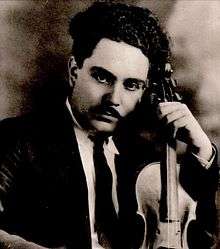String Quartet No. 1 (Revueltas)

String Quartet No. 1 by the Mexican composer and violinist Silvestre Revueltas was composed in 1930.
History
The score was completed in 1930 and is dedicated to Carlos Chávez (Espinosa Barco 2015, 93).
Analysis
The quartet is in two movements:
- Allegro energico
- Vivo
The first movement is regarded by one analyst as not following any conventional formal scheme, consisting instead of a series of contrasting episodes in different tempos and frequently changing meters that is similar to the Italian canzonas of the late-sixteenth and early seventeenth centuries (Luper 1952, 142).
According to another view, it is in a ternary, ABA form, which conflicts with the expected sonata-allegro form of the traditional string quartet (Baldassarre 2015, 463). The outer sections are fast, rhythmically irregular, loud, and aggressive, while the middle section contrasts with a slower tempo (Lento), regular rhythms, soft dynamics, and a lyrical, tender mood. The first section falls into four subsections (Allegro energico, Poco meno mosso – cantabile, Tempo I, and Meno mosso), each marked at the end by sustained chords, grand pauses, or both. The fourth subsection is a modified repetition of the second. The chromatic harmonies of the slow, B section are reminiscent of the slow passages in the String Quartet and Lyric Suite of Alban Berg. The concluding Allegro is a nearly literal repetition of just the third subsection from the first part of the movement (Leclair 1995, 105–106, 109–10).
The second movement is in the same fast-slow-fast ternary pattern as the first, but the two A sections are identical and divided into just two subsections. The slow middle section, unlike its counterpart in the first movement, is characterised by ostinato patterns and an eerie mood. Its metrical regularity contrasts sharply with the erratic rhythms of the outer, A sections (Leclair 1995, 105, 110–12).
Discography
In chronological order of recording.
- Cuartetos de cuerda de Silvestre Revueltas. String Quartets 1–4. Cuarteto de Cuerdas Latinoamericano (Jorge Risi and Aron Bitrán, violins; Javier Montiel, viola; Alvaro Bitrán, cello). Recorded in the Sala Carlos Chávez, Centro Cultural Universitario, June 1984. LP recording, 1 disc: analog, 33⅓ rpm, stereo, 12 in. Voz Viva de México: Serie Música Nueva. México: Universidad Nacional Autónoma de México, 1984. Reissued as Silvestre Revueltas: Los cuartetos de cuerdas, second edition. LP recording, 1 disc: analog, 33⅓ rpm, stereo, 12 in. Voz Viva 337–338. Serie Música nueva MN-22. [Mexico City]: Voz Viva, 1987.
- Silvestre Revueltas. Música de feria: The String Quartets/los cuartetos de cuerda. Quartet No. 1; Quartet No. 2, Magueyes; Quartet No. 3; Quartet No. 4: Música de feria. Cuarteto Latinoamericano. Recorded April 9–10, 1993, at the Carnegie Free Library, Carnegie, Pennsylvania. New Albion NA062CD. Classical Music Library. San Francisco: New Albion Records, 1993. Reissued as Revueltas String Quartets Nos. 1–4. Hong Kong : Naxos Digital Services Ltd., [2009], streaming audio (online resource).
- Martínez Bourguet String Quartet Plays Silvestre Revueltas. String Quartets 1–3 and Música de feria. Martínez Bourguet String Quartet (Pablo Arturo Martínez Bourguet and Ekaterine Martínez Bourguet, violins; Alessia Martínez Bourguet, viola; César Martínez Bourguet, cello). Recorded in the summer of 2006 in the Sala Carlos Chávez, Universidad Nacional Autónoma de México. CD recording, 1 disc: digital, 4¾ in., stereo. MB Producciones [s.n.]. [Mexico]: MB Producciones, 2007.
References
- Baldassarre, Antonio. 2015. "Negotiating History, Nation and the Canon: The String Quartets of Silvestre Revueltas". In Communication Music: Festschrift für Ernst Lichtenhahn zum 80. Geburtstag/Festschrift for Ernst Lichtenhahn’s 80th Birthday, edited by Antonio Baldassarre and Marc-Antoine Camp, 453–78 . Bern: Peter Lang. ISBN 978-3-0351-0806-4; ISBN 978-3-0343-1625-5.
- Bitrán, Arón. 1996. "Los cuartetos de Silvestre Revueltas". Pauta 16, nos. 57–58 (January–June): 30–35.
- Espinosa Barco, Blanca. 2015. Silvestre Revueltas y Carlos Chávez: Frente a Frente. California: Windmills Editions. ISBN 978-1-312-99658-8.
- Estrada, Julio. 2012. Canto roto: Silvestre Revueltas. México, D.F.: Fondo de Cultura Económica; Instituto de Investigaciones Estéticas, Universidad Nacional Autónoma de México. ISBN 978-60 7-16-0951-9.
- Leclair, Charmaine Françoise. 1995. "The Solo and Chamber Music of Silvestre Revueltas". PhD diss. Eugene: University of Oregon.
- Luper, Albert T. 1952. "Silvestre Revueltas: String Quartet No. 1". Notes, second series, 10, no. 1 (December): 142–43.
- Madrid, Alejandro L. 2001. "¿Influencias o elementos de retórica? Aspectos de centricidad en la obra de Silvestre Revueltas". Heterofonía: Revista de investigación musical, no. 122 (January–June): 19–38.